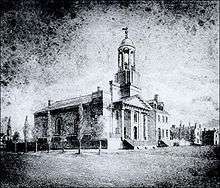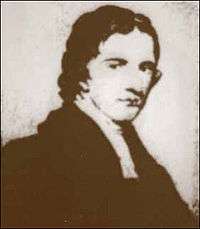Robert Little (minister)
| Rev. Robert Little | |
|---|---|
|
Rev. Robert Little - About 1800 | |
| Born |
1762 England |
| Died |
October 5, 1827 (aged 64–65) Washington, D.C. |
| Residence | Washington, D.C. |
| Nationality | British |
| Religion | Unitarian |
|---|---|
| Senior posting | |
| Based in | Washington, D.C. |
| Title | Reverend |
| Period in office | 1821–1827 |
| Religious career | |
| Post | Pastor, First Unitarian Church |
Robert Little (1762 – October 5, 1827) was a Unitarian minister.[1] He was born in England in 1762.[2] He immigrated to the United States in 1819[3] because of poor health and religious restrictions in England against all churches except the Church of England.[1] He was the first pastor of First Unitarian Church in Washington, D.C. and was instrumental in its formation in 1821. He served in that position until 1827 when he died an unexpected death.[4]
Biography
Rev. Robert Little's first charge was the Paradise Street Independent Church in Birmingham from 1791 until 1797. In 1797 he moved to Hanley in Staffordshire. From 1801 until 1806 he ministered to Perth Congregational Church.
Later he was pastor of the Little Cannon Street meeting house, built in 1809 by the congregation of Paradise Street chapel, formerly Congregational in Gainsborough, Lincolnshire, England which was closed in 1814. He moved in 1817 to a[5] Unitarian Church at Gainsborough.[6]
He had been educated in the Established Church of England, but had become a convert to Unitarianism about 1814 [7] after changing his views about infant baptism, the role of the minister, and congregational practices that "relied on the English notions of status."[8]
He had a long association with the Rev. John Campbell and Rev. James Kay, both former Baptists who had gravitated to Unitarianism. Both played important roles in the founding of the church in the United States.[8]
Little delivered a sermon before the Unitarian Tract Society of Birmingham, England, "which attracted great attention" shortly before he departed for America.[7]
After he arrived in the U.S. in 1819, Little settled in Washington, D.C. where he lived in East Washington on Pennsylvania Avenue.[9] He is presumed to have worked in the United States Treasury [10] and had originally planned on starting his own business because "the failure of his health rendered it necessary for him to withdraw from the ministry,"[7] however, he was "called into service by Unitarians in the community."[1]
Unitarian Church
Rev. Robert Little followed the teachings and legacy of Joseph Priestley, an early Unitarian. Once settled in Washington, Little continued to preach Priestleyan Unitarianism while at the same time, maintaining connections with the New England Unitarian's and "associating with members of the government."[8]
He was an early founder and the first pastor of the First Unitarian Church in Washington. He was elected to the position by members of the congregation in 1821 before the church was even built.[1]

Little was a member of the Friends of Unitarian Christianity in Washington. Their earliest meetings were held at the long room over the City Baths in C Street. The very first meeting, took place on July 31, 1820. Architect Thomas Bulfinch, who designed many important buildings in Washington, including the Capitol building, was appointed secretary of the society and Moses Young, Esq. was called to the chair.[7]
The group consisted of roughly a dozen members and held services, "which were attended by no more than forty souls, in a rented room."[8] Little was "properly elected" as their minister in November, 1821 and then set out to formally organize the group into the First Unitarian Church, Washington.[8]
Other founders of the church included John Quincy Adams and John C. Calhoun.[8]
At the meeting "provided for the last Resolution," it was determined that the new church should be strictly Congregational. Committees were appointed to solicit subscriptions for building a church edifice.[7]
The building was designed by Charles Bulfinch[11] and was completed early in 1822.[7] More than 400 members attended the ceremony when the church was dedicated on April 9, 1822.[4]
In his dedication sermon he looked forward to the future, "These walls will, I trust, bear witness that our lives have not been altogether useless to mankind. Some I hope may be better for our exertions in the cause of truth."[1]
One of Little's most famous sermons was called the Discourse on the Mystery of Christ which discussed the subject of Mystery, "as this term is used in the Gospel."[12] It was a refutation of the "late attack upon the system of Unitarianism by Anthony Kohlmann."[8]
Little's presence in the nation's capital "once again put English Unitarianism in the seat of the nation's government and he made the most of it."[8] He delivered a sermon before the United States House of Representatives titled Religious Liberty and Unitarianism Vindicated in defense of the church in America."[8]
As early as 1824, Rev. Little took an early stand against slavery which was legal in the District of Columbia at that time. The "majority of the early Washington Unitarian congregation was sympathetic with the Southern attitude on slavery." Many of the church's ministers had already spoken out against it.[4]
First Unitarian Church "struggled" for most of its early history despite having many "famous members." The congregation did not maintain the institution and by 1877 they reorganized under a new name, All Souls Church.[13]
Columbian Institute
During the 1820s, Little was a member of the prestigious society, Columbian Institute for the Promotion of Arts and Sciences, who counted among their members former presidents Andrew Jackson and John Quincy Adams and many prominent men of the day, including well-known representatives of the military, government service, medical and other professions.[14]
Personal
Rev. Robert Little took ill during a visit to see Rev. James Kay in Harrisburg, Pennsylvania in August, 1827.[15] The two men were "seeking to boost each other's spirits" and Little was also hoping to rest.[8] He had traveled in intense heat with his family to reach the Kay family home, and it is believed he suffered heatstroke.[7] The day before he took ill, he had delivered both morning and evening sermons in the Unitarian church in Harrisburg.[16]
He died unexpectedly from an inflammation of the brain on October 5, 1827 as a result of the illness he suffered visiting Harrisburg.[16] Little's body was taken "upriver" to Northumberland, Pennsylvania and he was buried alongside Joseph Priestley.[8] Rev. Frederich Farley, officiated at his memorial service.[1]
After settling their affairs in Washington, his family returned to Pennsylvania where they remained.[8]
References
- 1 2 3 4 5 6 Marshall, Bruce T. Unitarians and Universalists of Washington, Part 3. Arcadia Publishing, Charleston SC - 2010. Retrieved 2010-06-24.
- ↑ "Dictionary of Unitarian and Universalist Biography.". Unitarian Universalist Historical Society (UUHS) 1999-2009. Retrieved 2010-06-24.
- ↑ Cooke, George Willis. "Unitarianism in America" (PDF). American Historical Association, October 1, 1902. Retrieved 2010-06-24.
- 1 2 3 "A History of Social Justice at All Souls". All Souls Church, Unitarian - 2006. Retrieved 2010-06-24.
- ↑ "Religious History: Places of worship, A History of the County of Warwick: Volume 7.". The City of Birmingham (1964), pp. 434-482. Retrieved 2010-06-25.
- ↑ The Monthly repository of theology and general literature. From the National Intelligencer, June 12, 1822. Retrieved 2010-06-24.
- 1 2 3 4 5 6 7 Sprague, William Buell. Annals of the American Pulpit: Unitarian Congregational. Robert Carter & Brothers, New York. 1865. Retrieved 2010-06-25.
- 1 2 3 4 5 6 7 8 9 10 11 12 Bowers, J. D. Joseph Priestley and English Unitarianism in America. Pennsylvania State University Press, 2007. p.142. Retrieved 2010-06-25.
- ↑ "Newspaper Extracts - The Evening Star.". Newspaper Abstracts. Retrieved 2010-06-25.
- ↑ American Studies in Honor of William Kenneth Boyd. Duke University Press, 1940. Retrieved 2010-06-24.
- ↑ "A History of Unitarianism". Unitarian Universalist Association, Beacon Press - 1977. Retrieved 2010-06-25.
- ↑ The Unitarian miscellany and Christian monitor, Volume 2. The Baltimore Unitarian Society, John D. Toy, Printer. p.118, 1822. Retrieved 2010-06-25.
- ↑ Marshall, Dr. Bruce T. "What's in a Name?.". Davies Memorial Unitarian Universalist Church. November 8, 2009. Retrieved 2010-06-25.
- ↑ Rathbun, Richard. The Columbian institute for the promotion of arts and sciences: A Washington Society of 1816-1838. Bulletin of the United States National Museum, October 18, 1917. Retrieved 2010-06-20.
- ↑ "LFHS - Extracts from Newspapers of items concerning Lincolnshire People". Lincolnshire Family History Society, 2002. Retrieved 2010-06-24.
- 1 2 The Unitarian review and religious magazine, Volume 16. Office of the Unitarian Review, Boston; July, 1881. Retrieved 2010-06-25.
